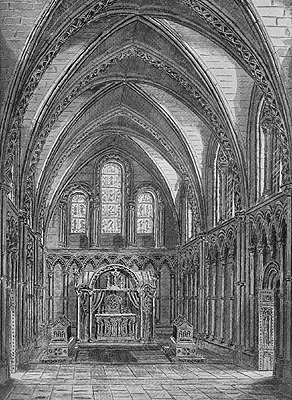
EBK Home
Kingdoms
Royalty
Saints
Pedigrees
Archaeology
King Arthur
Mail David
Glastonbury Shrines
Part 3: St. Patrick the Old
 Among the most important shrines at
Glastonbury was that to St. Patrick, Evangelist of the Irish. He is
usually thought to have been buried at Downpatrick in Ireland, but the
West Country monks disputed this and claimed that after Patrick's
episcopate in Ireland, he retired to Glastonbury and reluctantly took on
the running of the abbey. He died there and was buried to the right of the
High Altar in the "Old Church". This story was current as early
as the 10th century and many Irish pilgrims are recorded to have visited
his shrine. Unfortunately, doubt has been cast upon exactly which St.
Patrick Glastonbury held; particularly due to their differing feast days
(17th March V. 24th August). Some ancient records refer to two
contemporary St. Patrick's in Ireland, one known as the 'the Old,' the
other as 'the Young' or 'the Bishop'; the famous St. Patrick had a nephew
of the same name, son of Sannan the Deacon, and there was certainly at
least one other St. Patrick (ab Alfryd) active in Anglesey not long
afterward. The Glastonbury man was originally known as Sen Patrick or
Patrick the Old and thus it would seem that he was a completely different
character from the banisher of snakes who we all know so well. Legend says
St. Patrick the Old came from the Gower Peninsula in Wales. He travelled
to Ireland and became great friends with St. Patrick, the Irish apostle,
who told him that they would enter heaven together. But when the latter
died, he had to wait five months before St. Patrick the Old joined
him and the promise could be fulfilled. Modern scholars suggest that St.
Patrick the Old may be an alternative name for St. Palladius, the
original apostle of Ireland, sent by Pope Celestine to Ireland in AD 431,
some twenty-five years prior to Patrick. Problems with the identification
include his supposed death at Forddun in Scotland on 7th July.
Among the most important shrines at
Glastonbury was that to St. Patrick, Evangelist of the Irish. He is
usually thought to have been buried at Downpatrick in Ireland, but the
West Country monks disputed this and claimed that after Patrick's
episcopate in Ireland, he retired to Glastonbury and reluctantly took on
the running of the abbey. He died there and was buried to the right of the
High Altar in the "Old Church". This story was current as early
as the 10th century and many Irish pilgrims are recorded to have visited
his shrine. Unfortunately, doubt has been cast upon exactly which St.
Patrick Glastonbury held; particularly due to their differing feast days
(17th March V. 24th August). Some ancient records refer to two
contemporary St. Patrick's in Ireland, one known as the 'the Old,' the
other as 'the Young' or 'the Bishop'; the famous St. Patrick had a nephew
of the same name, son of Sannan the Deacon, and there was certainly at
least one other St. Patrick (ab Alfryd) active in Anglesey not long
afterward. The Glastonbury man was originally known as Sen Patrick or
Patrick the Old and thus it would seem that he was a completely different
character from the banisher of snakes who we all know so well. Legend says
St. Patrick the Old came from the Gower Peninsula in Wales. He travelled
to Ireland and became great friends with St. Patrick, the Irish apostle,
who told him that they would enter heaven together. But when the latter
died, he had to wait five months before St. Patrick the Old joined
him and the promise could be fulfilled. Modern scholars suggest that St.
Patrick the Old may be an alternative name for St. Palladius, the
original apostle of Ireland, sent by Pope Celestine to Ireland in AD 431,
some twenty-five years prior to Patrick. Problems with the identification
include his supposed death at Forddun in Scotland on 7th July.
